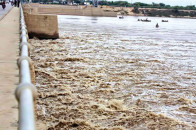Schools Education Department: Missing facilities project ‘on track’
Rs7.6 billion have been released so far, but no data is available to assess successes.

The funds were to be released in four instalments. The Rs1.8 billion first instalment was on August 28. PHOTO: FILE
The Schools Education Department (SED) claims to have released nearly half of the allocated funds for providing missing facilities in schools across the province.
The project was approved in July and Rs7.5 billion was earmarked to provide the missing facilities by December.
The funds were to be released in four instalments. The Rs1.8 billion first instalment was on August 28.
SED Deputy Secretary Qaiser Rasheed who has been overseeing the project since its inception, says the it is on schedule.
“The budget releases so far have been timely. These have been handed down to districts to replenish missing facilities by the end of this year,” he says.
The missing facilities defined for the project include toilets, boundary walls, clean drinking water and electricity. Missing furniture in classrooms will also be provided.
Rasheed says 40 per cent of the funds released so far have been used up in South Punjab.

He says funds have been released for schools in 11 districts of the Multan, Bahawalpur and Dera Ghazi Khan divisions.
He says no assessment of the progress of the project is available so far.
However, he says as many as 4,000 schemes for missing facilities have been initiated across the province.
Rasheed says Rs 3.8 billion allocated in the previous year to address the problem of missing facilities in schools was also available.
The SED says it has released Rs7.6 billion to districts to date under the project.
Half of this amount came from the project’s budget this year and the other half from last year’s allocation.
The Punjab School Education Sector Plan 2013-2017 report states that at primary, middle and high schools, a comparison of private and public sector schools showed public schools had more missing facilities than private schools.
At primary levels, boundary walls, clean drinking water, electricity and toilets were missing in more than 80 per cent schools of the province.
At the middle level, the situation is similar.
While 95 per cent of private schools have drinking water, more public schools have electricity than private schools.
At the high school level, public schools lead in boundary walls and cleaning drinking water compared to private sector and only marginally lag behind in provision of electricity and toilets.
The project for missing facilities does not include provision of additional classrooms in schools although the five-year sector plan for 2013-2017 had allocated Rs1.8 billion for this purpose.
According to official figures, schools across the province require more than 70,000 additional classrooms to maintain the student-teacher ratio at 50:1.
An agreement between the SED and the Department for International Development (DFID) is being negotiated for the construction of as many as 20,000 classrooms.
The SED has estimated the cost of constructing a classroom to be between Rs700,000 to Rs1 million.
Rasheed says it will take up to three years for completion.
Published in The Express Tribune, November 22nd, 2013.



















COMMENTS
Comments are moderated and generally will be posted if they are on-topic and not abusive.
For more information, please see our Comments FAQ